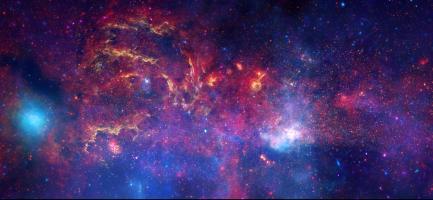Travel Back to the Beginning of Space and Time with the Smithsonian’s Exhibition, “The Evolving Universe”
The National Museum of Natural History has opened its newest temporary exhibition, “The Evolving Universe.” Breathtaking full-color photographs of the cosmos, taken by high-powered terrestrial and orbiting telescopes, take visitors back through time to the beginning of the universe. The exhibition, a collaborative effort with the Smithsonian Astrophysical Observatory at Harvard University, explores how the stars, galaxies and universe undergo the same stages as life on Earth: from birth, to maturity and, eventually, to death. This remarkable journey from present-day Earth to the far reaches of space and time will be on view on the second floor of the museum through July 7, 2013.
Scientists have used advancing technologies to explore the history and evolution of the universe. The light from stars and galaxies in the night sky has travelled for hundreds, millions or even billions of years. The light from the sun—a mere 93 million miles away—travels to Earth in only a few minutes. The night sky has stars in the Earth’s galaxy, the Milky Way. Light from the center of the Milky Way in the constellation Sagittarius has taken more than 26,000 years to reach Earth. When that light left its source, modern humans were becoming adept basket makers. Also included in the exhibition is an image of the microwave radiation emitted shortly after the Big Bang—a snapshot of the newborn universe 13.6 billion years ago, long before the first stars and galaxies formed. The universe has been expanding ever since.
“The photographs in this exhibition, made by remarkable instruments like the Hubble Space Telescope, show what a beautiful, yet, sometimes terrifying universe we live in,” said Glenn Macpherson, supervisory research geologist at the Smithsonian’s National Museum of Natural History. “You can also see actual dust grains formed 4.6 billion years ago during the explosions of ancient dying stars. These tiny supernova grains were trapped in our own our solar system when it formed, then preserved in meteorites where we can now study them; astronomy with an electron microscope!”
In addition to telescopic images from space, researchers are actively investigating microscopic images of meteorites found on Earth. Their composition reveals what changes have taken place in the universe during the passage of billions of years while the Earth was still in formation, well before humans even existed. All of the elements—the raw materials that make up everything in the universe, including the Earth and human bodies—are formed within stars and released into space when stars die. Visitors may be surprised to learn that their bodies are composed of this stardust and will be able to see an example of interstellar diamond dust found in a meteorite in 1969. This will join the compelling visuals and epic stories of supernovas, stellar nurseries, nebulae and galaxy clusters that reveal the fascinating history of the expanding universe.
“We’ve all seen the amazing pictures from NASA’s probes in our own solar system,” said Jonathan McDowell, a physicist of the Smithsonian Astrophysical Observatory. “I’m excited about bringing to the public the remarkable images of the broader universe that we astronomers have been exploring with our telescopes, and I hope that with this exhibition visitors will take away an appreciation for our larger cosmic neighborhood.”
For more information about the exhibition, visit www.mnh.si.edu/exhibits/. The Smithsonian Institution Traveling Exhibition Service will travel the exhibition to museums across the country beginning in fall 2013. Visit www.sites.si.edu for more information on the itinerary.
The Smithsonian’s National Museum of Natural History, located on 10th Street and Constitution Avenue N.W. in Washington, D.C., welcomes more than 6 million visitors annually. The museum is open daily from 10 a.m. to 5:30 p.m. Admission is free. For more information about the museum, visit it at www.mnh.si.edu and on Facebook, Twitter (hash tag #nmnh), YouTube and Flickr or call (202) 633-1000, TTY (202) 633-5286.
Smithsonian Astrophysical Observatory
The mission of the Smithsonian Astrophysical Observatory is to advance knowledge and understanding of the universe through research and education in astronomy and astrophysics. Headquartered in Cambridge, Mass., SAO is partnered with the Harvard College Observatory to form the Harvard-Smithsonian Center for Astrophysics. SAO addresses fundamental questions in astronomy and astrophysics, which range from the mysteries of the formation and evolution of planets, stars, black holes, galaxies and larger-scale structures in the universe, to those surrounding the dark matter and dark energy pervading it.
# # #
Suggested tweet: Travel back through time to the beginning of the universe with images from “The Evolving Universe” exhibition @NMNH. #nmnh
SI-411B-2011
Randall Kremer
202-360-8770





